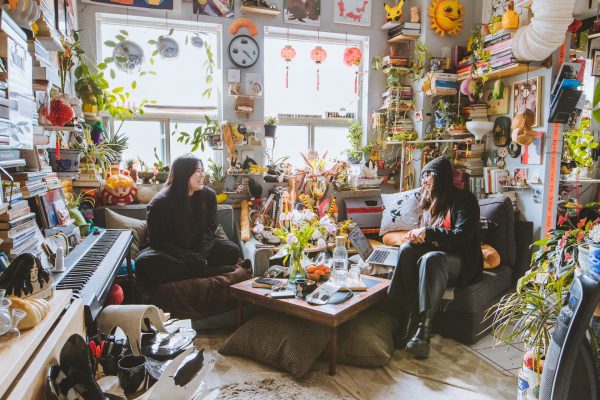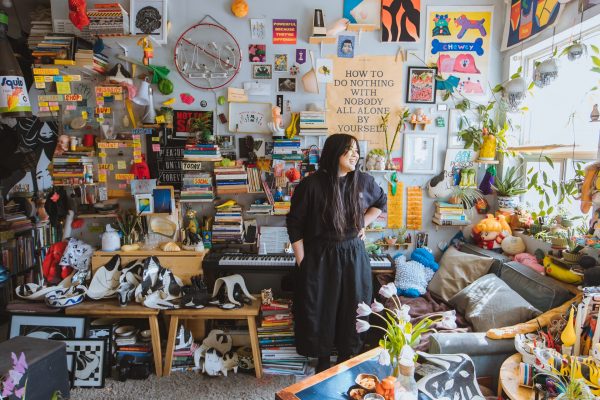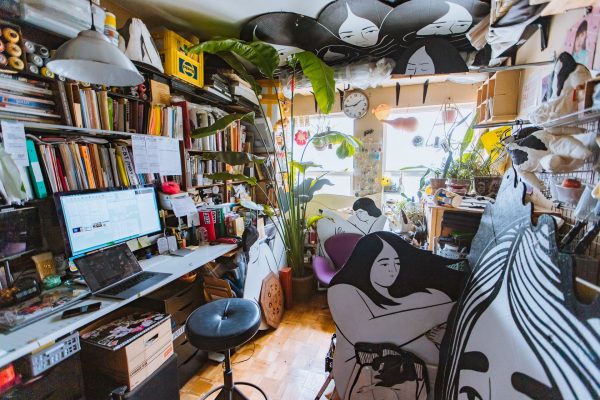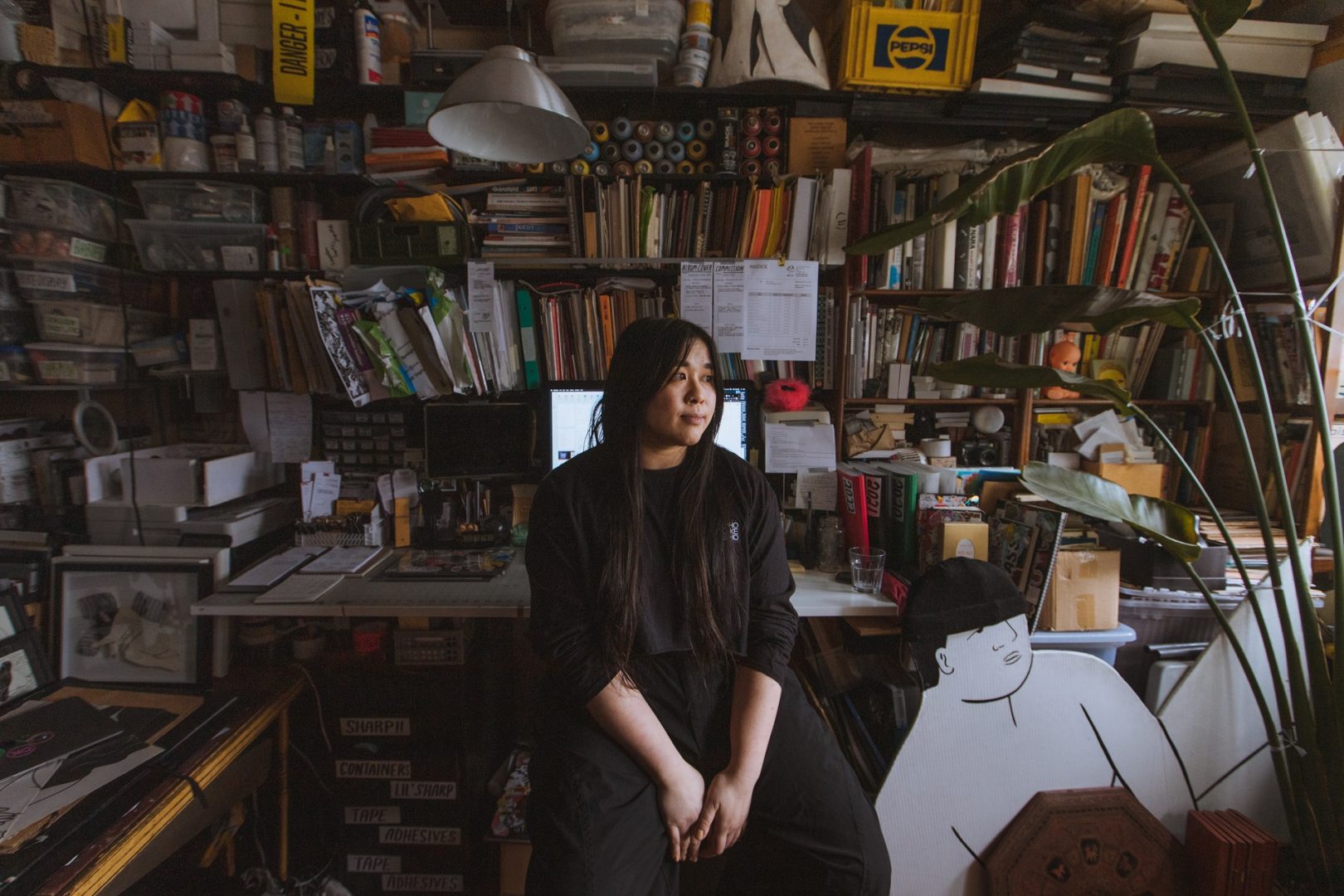By Meghan Yuri Young Photography by Max Power An exploration of the breadth of human emotions and form, Ness Lee’s work gives a language to the multidisciplinary artist’s self-reflection — and her vision of a…
By NowPlayingToronto
By Meghan Yuri Young
Photography by Max Power
Walls covered in posters. Plants. Books. Plants on top of books. Quirky and unique finds. Her own art. It’s no wonder that Ness Lee describes her home as a permanent Christmas tree. It’s a place brimming not only with memories, but also with inspiration. While it may appear chaotic to some, there’s a comfort of empowered vulnerability and a softness to Ness’s space.
In this way, Ness’s home is a reflection of her art, which has been described as, “an investigation of the human form dealing with notions of intimacy and self-love.” The emotions her personal space evokes start to make even more sense when you learn that Ness believes everything is delicately connected. People and places, identity and community, art and language — all of it weaves together in ways that invite exploration and the unexpected.

Meghan Yuri Young: Walking around the city of Toronto, you’re bound to pass by one or two of your murals, often involving your signature mermaid-haired characters. What do these characters represent to you, and for you?
Ness Lee: For me, they’re not so much particular characters as they are feelings. How big they are or how much they take up space is the feeling of it. A lot of it is also based on how they intertwine and hold each other. It’s an exploration of intimacy — sharing a space together.
MYY: Before we started the interview, you mentioned that you also walk everywhere in the city.
NL: Oh, yeah, I do. I fixate on everything. I’ll just walk and look at buildings, look at trees, like I’m a tourist.
MYY: Have you always been like that?
NL: No, not particularly. I think since I’ve been living here, I started to be more observant of my area.
MYY: Did you grow up in Toronto?
NL: I grew up in Markham.
MYY: What brought you to the city?
NL: I went to OCAD and stayed after I graduated. I’ve been here for, maybe, 10 years.
MYY: What made you stay?
NL: It’s a lot about being around all the things I love, like gallery shows, visiting studios, and also projects. Project-wise, it’s all here. And I like the energy. Because in suburbia I don’t feel anything, I don’t do anything. But here, I hear all the noise, all the racket, and I’ll be like, “Should I get up and do something?”
MYY: It’s motivating! How would you describe the energy of Toronto?
NL: It’s definitely weird, like a whoopee cushion or a water balloon. It’s nice and pretty, but you also don’t know what’s happening. Sometimes, I’m quite certain of what Toronto is and then it’ll just change and morph. Most times, I’m like, “What’s happening here?”. [The city’s] still growing.
MYY: Your work has been described as, “an investigation of the human form dealing with notions of intimacy and self-love.” You explore so much, with great feeling. But that exploration into vulnerability also evokes a sense of empowerment. What does this practice of introspection do for you and your art?
NL: When I started it, it was a lot of exploring my own feelings because of language. I’m Hakka, but I just speak English. Drawings and art became the language I used to express myself. So, when I had a feeling, I would just draw it. I noticed a lot of it was these yearnings and desires for intimacies. I think a lot of the time, I envision how I’d like to be held or how I’d like to be seen. I draw it and make it reality, in a way. But the drawings are not me! I know they look like me, but they’re my feelings.
MYY: They do look like self-portraits, but you’re adamant they’re not.
NL: I mean, I accept that it looks like me and whoever wants to take it that way can. But it’s like when you wanna learn how to draw a nose, you look in the mirror and draw noses. Then, the rest of it kind of became a habit of figurative drawing.

MYY: Shortly after we first met a few years ago, I asked you to speak at an open mic-style event. At the time, I felt like I was asking a lot from you, but you shared your history and journey with such openness. I would love to revisit your story as I believe it is relatable to many Torontonians.
NL: Growing up Hakka, I was part of a culture that, in my opinion, is diminishing in its language — at least for me. I didn’t have anyone to speak with aside from my grandma, so I didn’t have a chance to practice it much. I lost it. Also, the fact that my parents were born and raised in India, I grew up with a weird question of, “Then what are you?”
At the time, Markham was made up of a lot of immigrant families. English wasn’t their second language, but I felt a bit more out of the circle because I only knew English and not, like, [English plus] Mandarin or Cantonese. So, it was a very particular type of displacement — kind of a diasporic upbringing. I couldn’t quite find an identity or feel like I belonged. That definitely went into my work. I didn’t practice talking or expressing myself because of those things, but I also couldn’t find comfort in using language. I ended up using art. And a lot of it is the way I’d like to see things or envision how, for example, I’d like to be held or a world where there is that sensitivity for love and vulnerability, where it’s not a thing we get embarrassed of or hide from.
My queer identity also piles onto that. It goes a step further in not knowing who I am. Coming to the city and doing my art thing here, I found a lot of commonplace with other people. It was really nice to be able to share that understanding. It’s almost like a wordless understanding.
MYY: Are you finding a sense of belonging here?
NL: Sometimes I teeter with the answer to that question because I really do feel like I don’t belong or I’m too different. But I feel like Toronto is home. I believe everything is connected, very delicately connected. I really don’t think I would be doing what I’m doing without people I meet, support, work with, and just engage with in the city. That’s what makes it special and gives me that sense of belonging.
Toronto feels a bit tender sometimes, in a way where I feel like it doesn’t know what it is. With that relatable feeling, it feels a bit more comforting to be here.
MYY: You’ve managed to turn the streets and buildings into one big canvas. What is it like to leave your mark in spaces that maybe you might not have been able to decades ago?
NL: It’s an experience that I don’t take for granted. At the same time, I feel very hesitant because it’s in public spaces. Like a form of advertising, it accosts our eyes. I really do try to take in the environment or the context of the mural that I’m being asked to do, to make sure it reflects the intention or the area and community in general.
I want it to hold the community, you know? The energy of the piece. Nothing too different or too wild, just something quiet and connecting.
 MYY: That’s so interesting. You take up space conscious of what that means to someone else who maybe doesn’t know what your intentions were.
MYY: That’s so interesting. You take up space conscious of what that means to someone else who maybe doesn’t know what your intentions were.
NL: I do consider art, in general, to have undertones of extroversion or performance. Yet, I’m very introverted, so I have a sensitivity to that difference. I also like being conscious about presence. It’s important to me. How do we take up space — even metaphorically — in the airwaves or in someone’s thoughts? I think about that a lot.
MYY: What’s something that would surprise people, especially your fans who think they know you?
NL: Well, I have extroverted moments, but it’s mostly speaking to how comfortable I am. I’m very socially anxious. I think that’s why, when I am in public or presenting something, I will assume that understanding and do the thing. But it’s a very big stretch for me. In moments of privacy or intimate settings, it’s easier for me to share myself vulnerably.
MYY: You’ve also taken up spaces in world-renowned institutions like the AGO. Can you share how those opportunities came about, and what advice you may have for artists aspiring to do the same?
NL: It goes back to my mention of connectedness. I truly try to find the butterfly effect of everything: “How did I get this opportunity? Because someone believed in me.” To me, that’s why everything’s connected. At the same time, I never thought it would ever happen. I never saw someone like me doing it. At least I never considered my work in a big gallery, like an institutional gallery. When it does happen, I want to take full advantage of it. I want to experience what it’s like to take up space and live in a space like that.
But when it comes to getting those opportunities, I think it comes down to the explorative aspect of my work. My practice is definitely multidisciplinary. I try a lot of things, and with that, I get a lot of different opportunities because people see it in other ways. That’s helped me — that and a lot of trust.
For those who want to be artists, I don’t know! I feel that’s hard to answer. I don’t know how art happens in the city. It just happens. To me, artists make meaning of things. With that, I do believe the more you find whatever art you make or creative outlet, the closer you are to knowing yourself, discerning tastes, and all those little details. With that exploration and creating, things kind of line up in that way. It’s a continuous process. Maybe a more concrete answer is, receptivity. Just be open to anything and take it in when it comes. When I consider “things lining up,” I also think, “Are you open to accepting it?”
MYY: You have a signature style, which we not only see as paintings or sculptures but also as parachutes and pins. Is that all playful exploration, or is there anything more to that?
NL: I really like applying illustration onto functional things, like a tote bag. To me, it brings a different life to whatever the art is and the actual item is. When art is laid on various surfaces with different functionalities, it’ll live in a certain way in this world. I like to consider those things and like to let it live as it should. In a way, I’m kind of making a home for it. It does all come down to language. When I try a different medium, in my mind, I’m trying a different language to express myself and to express the tones I have for my work.
MYY: I feel as though sometimes our generation loves art, but do we collect art? Do we support our artists, or are we relying on grants and other investors to keep artists going? You have created this space of accessibility so people can own your art in different ways, not just to decorate their walls.
NL: I do get that comment a lot. It’s not necessarily something I consciously push forward to do. It kind of happens with the exploration stuff. Because of those explorations, I think of it as flexing creative thinking and fluidity. It’s divergent thinking to me, trying to express myself in those different ways and understanding how I feel about it. In turn, it creates that access because people digest things on different levels.
MYY: Where do you go for inspiration?
NL: My escape place is anything near the water. I’ll just sit and space out. I’m a water person. Other days, I like a good concert. To me, that’s ecstasy. I revel in bodies of people just enjoying something together. It’s really energizing for me. I also love to read. To me, reading a book, whatever it is — an interview or essay — is like an escape. I feel like it’s travelling. I also like to watch comedy because I like laughing at my pain.
MYY: The way you describe your draw to concerts, does music play a big part in your art?
NL: I love what I do but music, to me, is like that unreachable thing that I will always worship. Music is always part of my work. The way I make my work is a rhythm. The way your eyes travel on a page, to me, is like a conductor’s wand, and you’re dancing with the lines of the drawing. What I crave is a flow state. I feel that with music.
MYY: What are your favourite bookstores?
NL: Rare, vintage, weird bookstores. Secondhand, definitely. To me, books are a peak into someone else’s world or a different world. So, I love to go to bookstores like Acadia. Also, Value Village. I really love looking at things that have lived a life and are waiting to live another.
Ness is most well known for her public art displays. Discover how Toronto can be turned into a canvas by checking out upcoming outdoor events and visual art displays. You can also learn how to enjoy Toronto’s cultural offerings under an open sky with our blog about the city’s outdoor programming.

